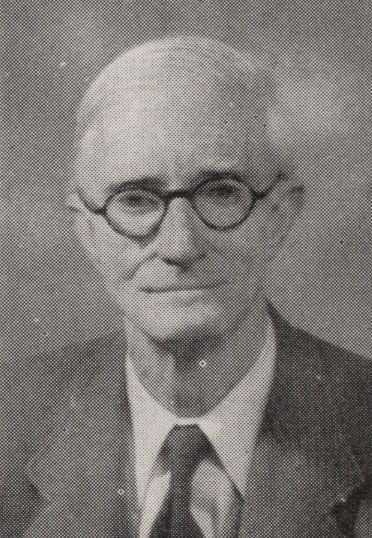The IET Archives recently received a donation of the technical and work papers of George F Shotter FIEE (1886-1971), who was an electrical measuring instrumentation specialist. The above photograph shows George in the mid 1920’s when he was the first President of the Meter Engineers’ Technical Association (META), which was formed in 1926. The image appeared in the June 1927 issue of Proceedings of the Meter Engineers’ Technical Association, just after he had been elected President for his 2nd year in office.
George Frederick Shotter
George Frederick Shotter was known internationally for his work in the field of electrical measurements. He had over 100 patents to his name and wrote numerous papers on the jewels and pivots of integrating meters.
George spent his career working for the North Metropolitan Electric Power Supply Company (Northmet) which he joined in 1906 at the Willesden Power Station. He was appointed Test Assistant at the Power Station in 1913, and then in 1922 he was transferred to the Outside Department, New Southgate. In 1927 he was appointed Meter Superintendent responsible to the Manager, Outside Department, where amongst other things he was concerned with the development of the Northmet Testing Laboratory. In 1943 he became responsible to the General Manager, and George held this position until he retired in 1951.
Whilst working for Northmet George undertook extensive technical work for the British Electrical and Allied Industries Research Association which by the mid-1930s was commonly referred to as the Electrical Research Association (ERA), for whom he wrote many reports. According to George’s obituary which appeared in IEE News in November 1971, this work was “generally acknowledged as unique, was widely read, and the results were applied all over the world”.
Following his retirement George carried out research for Gulf Oil, the Electricity Generating Board and the Coal Board and he continued writing technical articles well into his 80’s. The image below is taken from an article he wrote in 1969 on ‘the testing of meter and instrument oils’, and there is even a rough proof amongst his papers for an article destined for the Electrical Review in 1971 (the year that George died, aged 84).

Together with George Frank Tagg he wrote the book ‘induction-type integrating meters’, published by Pitman & Sons in 1960, and it was Tagg who wrote George’s obituary in IEE News. In that obituary Tagg listed George’s notable contributions as follows;
“His interests were not confined to this [his work on meter jewels and pivots], and he made notable contributions in other branches of electrical measurements. During the Second World War he was concerned with aspects of the electrical control system of tanks [more of this later], and he did considerable work in fault location and in the applications of electricity to medicine.”
George joined the IEE as an Associate Member in 1928, became a Member in 1935, and a Fellow in 1966. He served on the IEE Meter & Instrument Section Committee in 1929-31 and 1934-45, being Vice-Chairman in 1935-36 and Chairman in 1936-37. He was also a member of the IEE Measurement Section Committee from 1942-45.
His various papers gained 6 IEE Premium Awards including; the Meter & Instrument Section Premium in 1934; the Kelvin Premium in 1945; the John Hopkinson Premium in 1949; and the Sebastian de Ferranti Premium. He was also awarded the Centenary Medal from New Zealand for his paper on the subject of earthing.
The G F Shotter Papers
The majority of the papers in the collection are related to George’s numerous patents, his reports for ERA, and his published papers. Amongst his patent papers, it is fascinating to observe the amount of income that George earned, separately from his Northmet salary but obviously permitted by his Northmet employee contract, from licensing his patents to other companies, particularly to the instrumentation firm Elliott Brothers (taken over by English Electric in 1967). Royalty statements from Elliott Brothers are contained within the papers and these show for example that George earned £453 from the company for the half-year ended 31 December 1952 (the average UK house price at the end of 1952 was just under £1,900). Elliott Brothers even had a product that included Shotter’s name, the AC/DC Comparator (Shotter-Hawkes). The product leaflet for this item is shown below.

WWII Tank Turret Control Systems
George’s obituary mentioned that he worked on electrical control systems for tanks in the Second World War. Amongst the technical files in the collection is a file titled ‘[tank] turret test rig’. The file includes reports and correspondence related to work performed by Shotter on the development of a tank turret test rig to test new designs of gunnery and traverse equipment. Such a test rig was intended to avoid the use of field trials using an actual tank against real targets in open country. The images below show; the turret with traverse equipment mounted; the target track scenery; a target mounted on a locomotive; and the layout of instruments and the recorder for the test rig.




Following George’s work, he received a letter from A T Priddle, Assistant Director (electrical), Ministry of Supply, dated 21 September 1943 which thanked Shotter for, ‘the very excellent piece of engineering you have supplied us with for the purpose of testing gunnery and traverse gear’. The letter also said that the late Director General was going to the USA and was anxious to take some data on this subject and therefore they wanted Shotter to draw up a brochure with a full description and photographs.
For those wishing to explore the G F Shotter papers further, they have been catalogued with an archive reference SC MSS 287 and are available to consult by appointment at the IET Archive Centre, Savoy Hill House, London.

1 Pingback